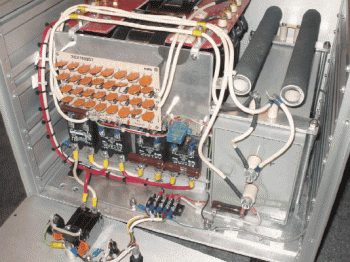This is a document that explains the design and development of power RF amplifiers applied in an Amateur Radio station. An amplifier may possibly necessary to build as much as 1500W of RF output power, the legal maximum in the United states.
Every single part in an power RF amplifier has to be properly selected to endure high electrical stress levels without having failing. Major amounts of heat are generated in the amplifier and need to be dissipated properly. Generation of spurious signals need to be reduced, not just for legal motives, but in addition to protect good neighborhood relationships. Every one of these challenges has to be overcome to make a loud, clean signal from a secure and dependable amplifier.
Download the document chapter about RF Power Amplifier:
» Download Link
About RF Amplifier
An RF power amplifier is a type of electronic amplifier which is utilised to convert a low-power radio-frequency signal into a larger signal of significant power, usually for driving the antenna of a transmitter. It is usually optimized to have high efficiency, high output Power (P1dB) compression, good gain, good return loss on the input and output, and optimum heat dissipation.
The basic applications of the RF power amplifier include driving to another high power source, driving a transmitting antenna, microwave heating, and exciting resonant cavity structures. Among these applications, driving transmitter antennas is most well known.
More explanation about power audio amplifier can be found at wikipedia.org
This is a demonstration about 01A RF Amplifier which is build used old tube component to amplify the signal. An RF power amplifier is a type of electronic amplifier which is utilised to convert a low-power radio-frequency signal into a larger signal of significant power, usually for driving the antenna of a transmitter. It is usually optimized to have high efficiency, high output Power (P1dB) compression, good gain, good return loss on the input and output, and optimum heat dissipation.
The basic applications of the RF power amplifier include driving to another high power source, driving a transmitting antenna, microwave heating, and exciting resonant cavity structures. Among these applications, driving transmitter antennas is most well known.
More explanation about power audio amplifier can be found at wikipedia.org
Watch the video:

No comments:
Post a Comment